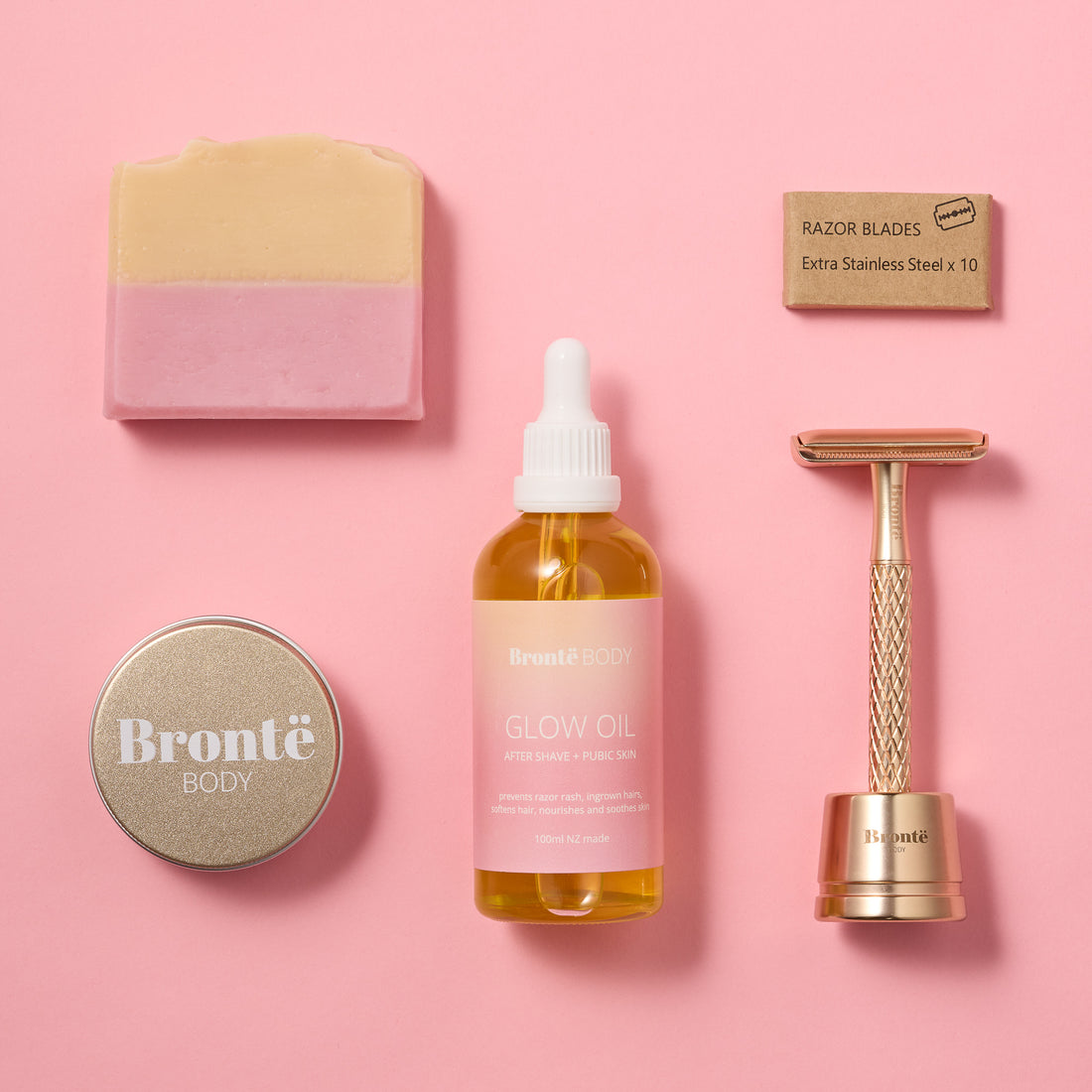How to use safety razor for first timers
3 min read, last updated 21-August-2023
Ready to level up?
Discover how to achieve your best shave yet with Bronte Body's beginner's guide. From correct razor assembly to after-shave care, we'll cover everything you need to know. Say goodbye to razor burn and ingrown hairs and say hello to a smooth, healthy complexion.
First things first
The most important point to take away is for shaving with a Bronte razor: No Pressure
For safety razor beginners
Congratulations on your new safety razor and shaving plastic-free and toxic-free! You are about to learn a new skill, so please be patient with yourself. Especially for the first few times do not shave under time pressure. Trust me on that one.
The main differences to disposable or other razors is the weight and the flexible head. Do not apply pressure when shaving, the weight of the Brontë Body safety razor is enough. For the non-flexible head: Shaving strokes should be short (1-2cm) especially around curves such as ankles and knees.Assemble the three parts of the safety razor - the handle, top and bottom headpiece. The blade goes between the two headpieces, held by the short ends. Ensure that the ridges of the bottom headpiece face up, or it won't cut. Always hold the blade by the short end as it's very sharp.
Correct Razor assembly
The safety razor is made of three parts. The handle and the top and bottom headpiece. The blade goes between the two headpieces (hold the blade by the short ends). Make sure the ridges of the bottom headpiece are facing up otherwise it won't cut. Always hold the blade by the short end. It's very sharp!

Blade
A clean, sharp blade is essential for a close shave. Change your blade every 5-7 shaves depending on how much you shave and the thickness of your hair. Leaving your razor in a wet, humid shower will quicken the dulling process, cause the blades to rust, and allow for bacteria to accumulate.
The older the blade, the more bacteria it has which can cause razor burn! Change your blades frequently! Remember, blades are much cheaper now. Blades can only be recycled at a metal recycling station (not the normal one) More recycling details here.
Exfoliation
Exfoliation removes dead skin cells and allows for a closer shave. It also helps prevent ingrown hairs. Use a body scrub or an exfoliating cloth before shaving and two days after. For the face, use a gentle exfoliant to prevent micro tears on your skin. Learn here how to diy your body scrubs.Prep your skin and Soften your hair
Shave at the end of a warm bath or shower to soften your hair, making it easier to cut. Wet hair is only half as strong as dry hair.
Shaving Lubricant
A rich oil provides moisture and glide for a smooth shave. Our Pure or Glow shave oil made from New Zealand organic hemp seed oil is perfect. The oil provides extra glide and puts a protective layer on your skin, minimizing irritation. Apply oil with one hand and shave with the other.
Alternatively use a rich shave soap with pink clay for an extra smooth shave. Simply cut the soap in half, let it run under warm water for a bit and then rub in your hands for about 30 seconds until the lather on your hand is so creamy that you can hardly scoop it off your hand.
The fattier the substance the less friction between skin and razor, resulting in less skin irritation.That is why our favourite way of shaving (especially on the bikini area) is to first apply the oil and then a bit of soap for a smooth shave. That will prevent the razor from clogging up.
Last option is to add some oil to your bath and shave away.
Shaving Style
Follow the next steps for your closest shave EVER!
Hold your razor in a 30-degree angle and shave in short strokes without applying pressure on your skin. Shave with the hair growth for softer, smoother skin. For a closer shave, stretch the skin plus you can shave up against the direction of hair growth. Do not shave under time pressure.
Shaving up, against the direction of your hair growth, gives you the closest shave for the smoothest skin. But your skin can get irritated if your hair is on the longer side, so start by shaving with the grain. This will shorten the hair, and then you can do the reverse – it’s your best solution for softer, smoother skin.
This method is recommended when shaving your bikini area.
Choose with the hair growth if you have very sensitive skin or very hard stubbles (and soak these). Strokes should be short and slow as the razor does not have a flexible head and you want to get all the hair especially around the bony bits.
Shave tips for knees and elbows - never cut yourself again
Do not apply pressure. The weight of the razor is enough pressure to get your close shave. Rinse razor when full.
After Shaving
Rinse your skin with cool water after shaving to close all the pores and reduce the chance of irritated skin. Apply shave oil to moisturize your skin and promote skin healing. If you have not used the shave oil for shaving you can apply it ow on your wet body to moisturize your body and promote skin healing. Lock in moisture with a soothing moisturizer, oil or gel containing healing ingredients such as hemp seed oil and aloe vera.
Once you are towel dry, lock in the moisture, and repair the film that protects the skin’s surface with a soothing moisturizer, oil or gel. Preferably including healing ingredients such as hemp seed oil, aloe vera, calendula. Have you seen our shave oil yet?
Protect and Clean Your Razor
Disassemble or half open up your razor and rinse all the parts. Air dry on a clean towel and store all parts in a dry and safe place - preferably in its razor stand. To prevent bacterial growth, clean your razor periodically by soaking in hot water and soap. Do not use strong detergents as they may affect the protective coating.
With these tips, you'll achieve a perfect shave every time. Happy shaving with Bronte Body's safety razors!
Summary- Your perfect shave tips
- No pressure on skin.
- Shave in short strokes.
- Take your time.
- Swap blades frequently.
- Shave at the end of a shower or bath.
- Exfoliate skin before shaving.
- Use a gentle shave soap, gel or oil.
- Shave first with the hair growth then against.
- Stretch your skin when shaving.
- Rinse with cold water.
- Apply soothing after shave oil.
- Unscrew razor, rinse under tap and let dry in its stand outside of shower.
Have fun!
Thank you so much for your support!
Together we make the world a better place all along while feeling happy and confident with or without body hair - that's up to you.
Love, Helen xx

